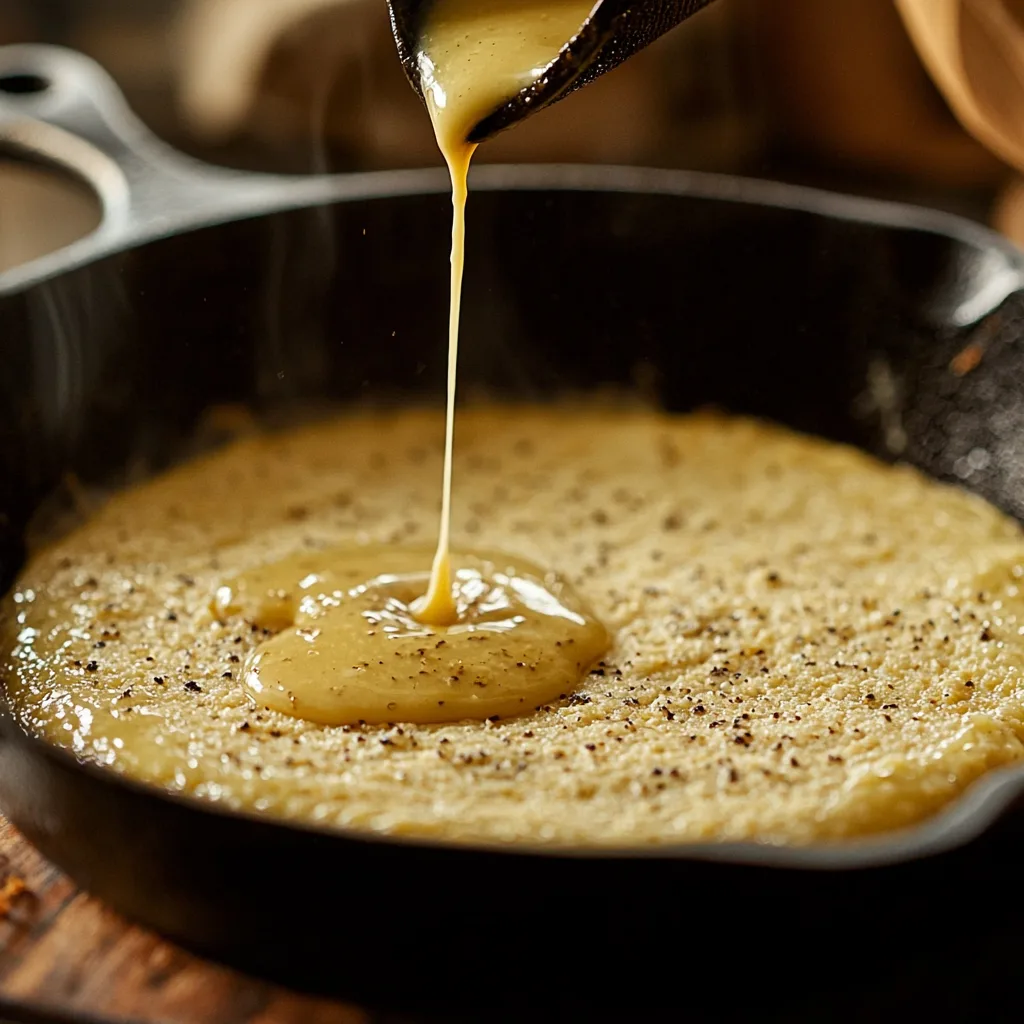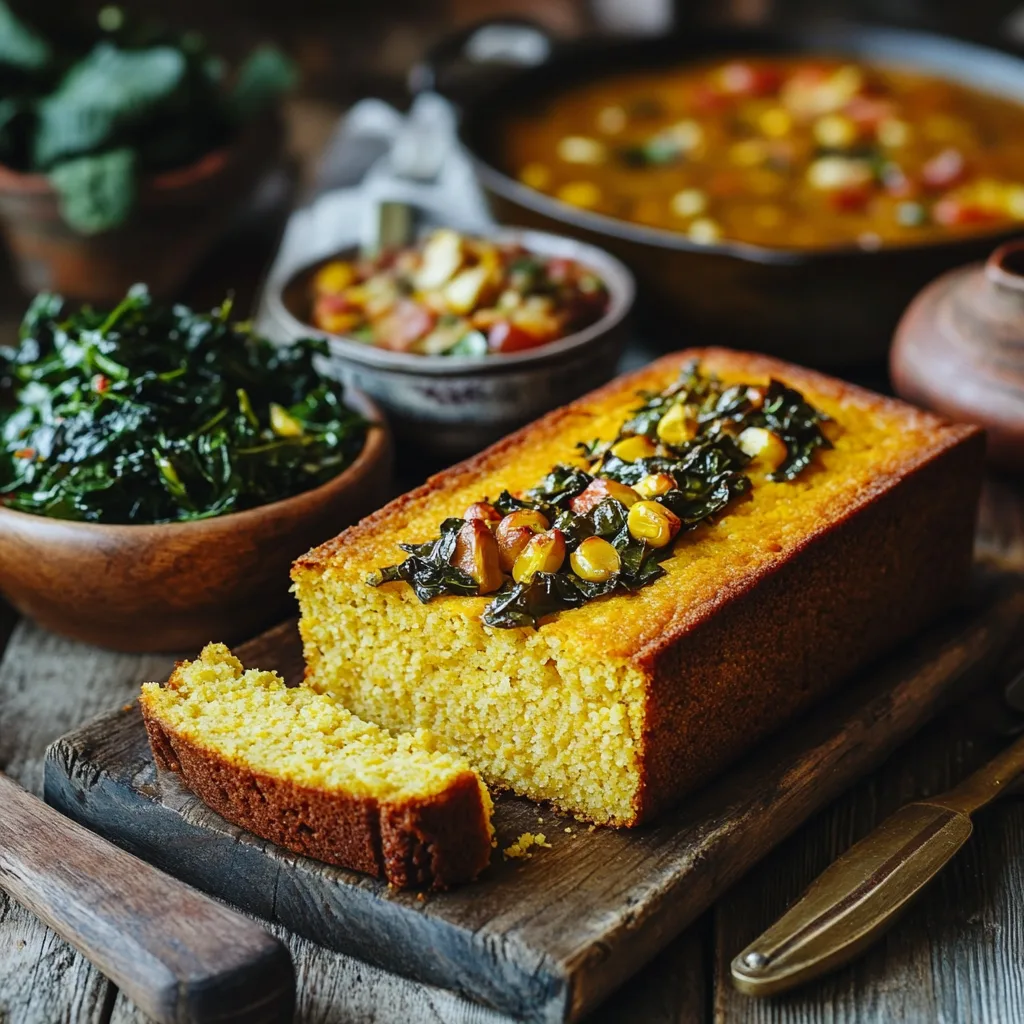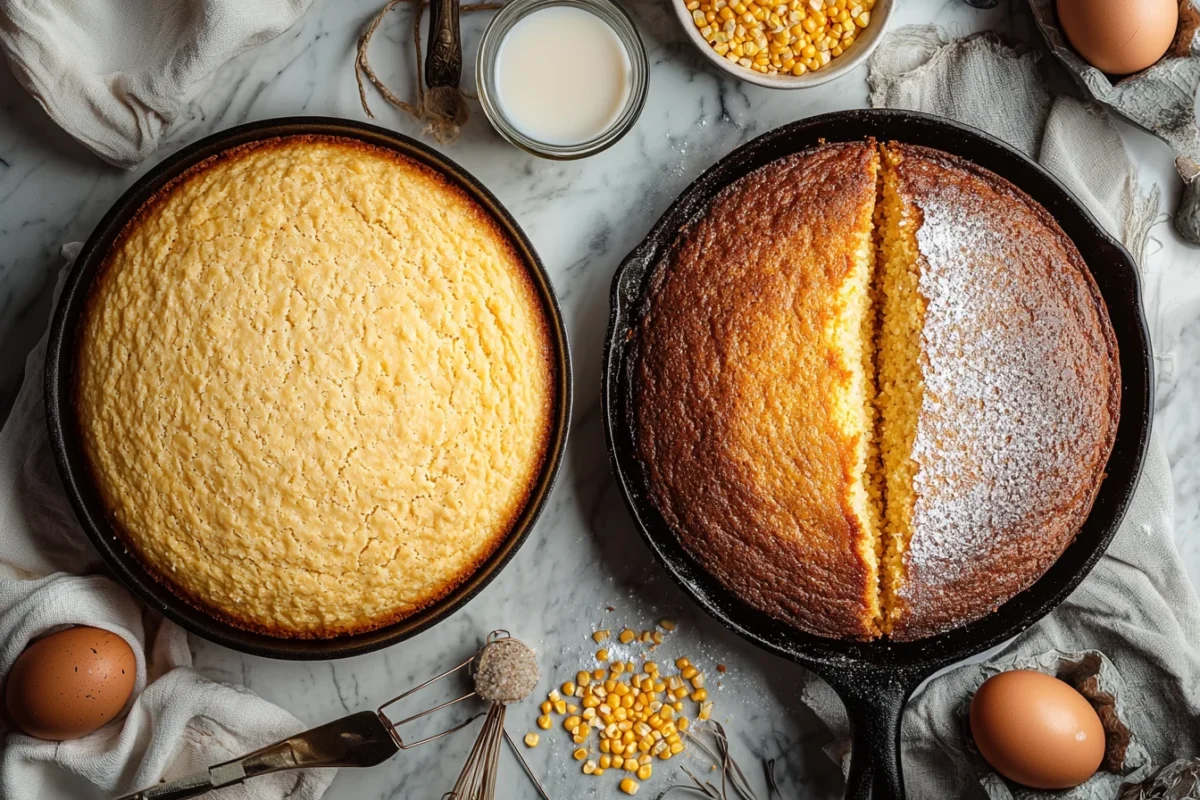Cornbread is a beloved classic across the United States, but not all cornbread is created equal. What is the difference between cornbread and Southern cornbread? Many food lovers ask this question when exploring this comforting dish. The difference goes beyond flavor—it’s about history, tradition, and unique preparation methods.
Traditional cornbread leans slightly sweet and cake-like, while Southern cornbread stays true to its savory roots with a crispy crust. Each style has its charm, and understanding these differences helps you pick the perfect version for your table.
Cornbread isn’t just a side dish; it represents warmth, comfort, and shared meals. Whether you prefer it golden and crumbly or soft and slightly sweet, there’s a cornbread style for everyone.
So, grab your skillet, preheat the oven, and let’s dive into the delightful world of cornbread! You’ll love discovering the unique traits of each style.
Table of Contents
Exploring the Roots of Cornbread Traditions
How Cornbread Became a Staple in American Cuisine
Cornbread has deep roots in American history, dating back to Native American communities. They used ground corn to create flatbreads and porridge-like dishes. Over time, European settlers adapted these methods using available ingredients like milk and eggs. This simple yet versatile bread earned its place as a household staple across the United States. You can learn more about the history of cornbread in American cuisine from the National Agricultural Library, which explores how corn became a fundamental part of the American diet.
Next, cornbread became a symbol of resourcefulness and survival, especially in regions with limited wheat supplies. It was easy to prepare, affordable, and filling for growing families. As settlers spread across different regions, unique variations of cornbread began to emerge.
Northern recipes often leaned towards sweetness, while Southern styles stayed savory. Each approach reflected local ingredients and preferences. Today, cornbread remains a beloved side dish with countless regional twists. Whether paired with hearty stews or enjoyed on its own, cornbread carries a legacy of tradition and adaptability. You’ll love discovering its rich history bite by bite!
The Southern Influence on Cornbread Recipes
Southern cornbread stands out for its bold flavors and rustic charm. Unlike Northern varieties, Southern recipes skip sugar, focusing on savory notes instead. This style emerged from necessity, using ingredients readily available in the South.
For example, beef tallow or bacon grease often replaced butter for cooking, adding a rich depth of flavor. In addition, Southern cornbread is traditionally baked in a cast-iron skillet. This method creates a crispy, golden crust that’s hard to replicate with other tools.

Another important difference lies in texture. Southern cornbread often uses coarser cornmeal, giving it a more rustic bite. Its hearty flavor pairs perfectly with dishes like collard greens or barbecue.

Over time, this recipe became a symbol of Southern hospitality and tradition.
Every slice tells a story of resourcefulness, community, and shared meals. If you’ve never tried true Southern cornbread, you’re in for a treat! For an authentic taste experience, check out this Southern Cornbread Recipe with Beef Tallow to discover the traditional techniques and ingredients that make Southern cornbread so special.
Key Ingredients That Set Them Apart
Classic Ingredients in Traditional Cornbread Recipes
Traditional cornbread recipes have a few key ingredients that make them stand out. First, cornmeal is the star of the show. It provides the signature flavor and texture that cornbread is known for. Northern-style cornbread typically uses finer cornmeal, resulting in a smoother texture.
Next, eggs and milk are common additions. They bind the batter together and add moisture to prevent crumbliness. In many recipes, sugar is added to create a slightly sweet flavor profile. This subtle sweetness makes Northern cornbread resemble more of a cake-like texture.
Butter or oil is often used for richness and to keep the bread tender. Additionally, some recipes might include a leavening agent, like baking powder, to help the bread rise.
With these ingredients, traditional cornbread achieves a soft texture and mild sweetness. It’s a versatile side dish that pairs well with soups, chili, or even served as a standalone snack.
Essential Ingredients in Southern Cornbread
Southern cornbread takes a different approach when it comes to ingredients. The most significant difference lies in the use of coarse cornmeal, giving it a more rustic and hearty texture.
Next, traditional Southern cornbread rarely includes sugar. The focus is on savory, natural corn flavors rather than sweetness. In addition, buttermilk is a key ingredient. It adds tanginess and moisture, resulting in a tender crumb.
Another essential component is beef tallow or bacon grease, which provides a rich, savory flavor. This choice of fat also contributes to the crispy crust Southern cornbread is famous for.
Eggs are included to bind the batter and add richness. Additionally, baking powder ensures the bread rises properly without becoming too dense.
These carefully chosen ingredients create a dish that’s savory, filling, and packed with traditional Southern charm. Every bite is a delicious tribute to time-honored cooking traditions.
Texture and Flavor Differences Explained
The Role of Texture in Defining Each Style
Texture plays a significant role in distinguishing how traditional cornbread compares to its Southern counterpart. Traditional cornbread, often found in Northern recipes, tends to have a cake-like texture. This softness comes from the use of fine cornmeal and added sugar.
On the other hand, Southern cornbread has a denser, more rustic feel. Coarser cornmeal creates a firmer crumb, and baking it in a cast-iron skillet adds a crispy crust. Additionally, Southern cornbread relies on buttermilk and savory fats like bacon grease or beef tallow for moisture.
These differences in texture often determine how the cornbread pairs with other dishes. Northern cornbread works well with sweet spreads like honey or jam. Meanwhile, Southern cornbread complements hearty dishes like stews and beans.
Both styles have their charm, but texture sets them apart significantly. Once you try both, you’ll quickly notice the difference in every bite!
Comparing Flavor Notes Across Cornbread Variations
Flavor is another key factor that separates traditional cornbread from Southern cornbread. Northern-style cornbread leans slightly sweet, thanks to the addition of sugar. This sweetness balances the natural corn flavor and creates a more dessert-like experience.
Meanwhile, Southern cornbread is all about savory richness. It skips sugar and focuses on bold, natural corn flavors enhanced by savory fats like beef tallow or bacon grease. In addition, buttermilk in Southern recipes adds a tangy note that elevates the overall taste.
Another key difference lies in how the bread absorbs flavors. Southern cornbread, with its coarse texture, soaks up sauces and stews beautifully. Traditional cornbread, on the other hand, works well as a standalone dish with butter or honey.
Both versions bring something unique to the table, and each has its own loyal fanbase. Whether you prefer sweet or savory, cornbread has a place in every kitchen.
Cooking Techniques for Cornbread Variations
Baking Methods for Authentic Cornbread
The baking method significantly influences the contrast between classic cornbread styles found in different regions. Traditional cornbread is often baked in standard baking pans or even muffin tins. This method creates an evenly baked, smooth-textured bread.
It’s a simple and effective approach that works well for sweeter cornbread styles. In contrast, Southern cornbread is almost always baked in a cast-iron skillet. This technique creates a golden, crispy crust that can’t be achieved in regular pans.
Preheating the skillet before pouring the batter ensures a perfect sizzle and crust formation. In addition, the skillet helps distribute heat evenly, preventing uneven cooking.
Another technique often used in Southern recipes involves greasing the skillet with beef tallow or bacon fat. These fats add a deep richness that’s hard to replicate.
Whether baked in a skillet or pan, the cooking technique heavily influences the final texture and flavor.
Why Cast-Iron Skillets Are a Southern Favorite
The cast-iron skillet isn’t just a tool; it’s a tradition in Southern cooking. When making Southern cornbread, the skillet plays a key role in creating the perfect crispy crust.
First, it retains heat exceptionally well, ensuring even baking from edge to center. Next, preheating the skillet before pouring the batter creates an instant sizzle, forming that signature golden crust.
In addition, using fats like beef tallow or bacon grease in the skillet adds flavor directly to the bread. This simple step creates a depth of taste that’s impossible to achieve with other cookware.
Skillets are also incredibly durable, making them perfect for generations of home cooks. Whether served straight from the skillet or flipped onto a platter, the cornbread carries a rustic charm.
In Southern kitchens, the cast-iron skillet isn’t just a tool—it’s a piece of history. Every bite carries the legacy of well-seasoned cookware and traditional techniques.
Cultural Significance of Cornbread Across Regions
Cornbread in Northern vs Southern Traditions
Cornbread holds a special place in both Northern and Southern culinary traditions, but each region approaches it differently. In Northern regions, cornbread is often sweeter and lighter, resembling a cake-like texture. Sugar is a common ingredient, and finer cornmeal creates a smoother crumb.
On the other hand, Southern cornbread has a heartier texture and leans toward savory flavors. It’s usually made with coarser cornmeal and cooked in a cast-iron skillet. This method creates a crispy crust while keeping the inside moist and fluffy.
Next, cornbread in the South isn’t just a side dish; it’s a cultural icon. It’s served alongside hearty meals like barbecue, collard greens, and stews. Meanwhile, Northern cornbread often appears with soups or even as a standalone snack with honey or butter.
Despite their differences, both styles are celebrated for their unique flavors and deep cultural roots. Each bite tells a regional story worth savoring.
How Culture Shaped Cornbread Preferences
Cultural traditions have played a key role in shaping how cornbread varies across regions in the United States. In the North, cornbread became a comforting staple during long winters. The addition of sugar reflected the abundance of sweeteners in those regions.
Meanwhile, Southern cornbread evolved in a warmer climate, where savory flavors and skillet cooking became the norm. Resourcefulness played a key role in shaping Southern recipes. Ingredients like beef tallow and buttermilk were commonly used to enhance both flavor and texture.
In addition, cornbread in the South became a symbol of community and shared meals. Whether served at family dinners, church potlucks, or holiday feasts, it brought people together.
Northern cornbread, while equally cherished, became more associated with casual meals and baked goods. Both versions carry cultural pride and tell a story of resilience, creativity, and resourcefulness.
At the end of the day, cornbread isn’t just food—it’s a connection to heritage.
Common Myths About Cornbread Styles
Clearing Up the Sweet vs Savory Debate
One of the most common myths about cornbread revolves around its sweetness. Many people believe all cornbread should be sweet, while others argue it should always be savory. The truth is, it depends on where you are and who’s baking it.
In Northern regions, adding sugar to cornbread is traditional and widely accepted. This sweetness balances the natural earthiness of cornmeal and creates a softer, cake-like texture. However, in the South, sugar is often considered unnecessary and even frowned upon in traditional recipes.
Another myth claims it must always be dense. While Southern cornbread often has a coarser texture, it can still be light and fluffy if prepared correctly.
Additionally, some believe that cornbread always needs butter to taste good. While butter adds richness, traditional Southern cornbread relies on beef tallow or bacon grease for its iconic flavor.
In the end, both styles have their strengths, and neither is better.
Regional Misconceptions About Cornbread
There are plenty of misconceptions about what is the difference between cornbread and southern cornbread. One myth is that all Southern cornbread is dry and crumbly. In reality, when made correctly, Southern cornbread is incredibly moist and flavorful.
Another misconception is that Northern cornbread is always overly sweet. While sugar is common in Northern recipes, it’s usually added in moderation to balance flavors rather than overwhelm them.
In addition, many people believe that Southern cornbread must always be baked in a cast-iron skillet. While this is the traditional method, some cooks prefer baking it in regular pans and still achieve great results.
Regional pride often fuels these myths, with each side claiming their version is superior. But the truth is, both styles have their appeal and cultural significance.
At the end of the day, cornbread—whether Northern or Southern—remains a beloved dish enjoyed nationwide.
Frequently Asked Questions (FAQs)
Why is southern cornbread not sweet?
Southern cornbread focuses on savory flavors instead of sweetness. Historically, sugar wasn’t common in Southern kitchens. Cornbread was made to accompany hearty dishes, not as a treat. Instead of sugar, ingredients like buttermilk or beef tallow enhanced richness and texture.
Southern cornbread complements savory meals like beans, greens, or barbecue. Adding sugar would disrupt its traditional flavor balance. Today, many Southerners still prefer their cornbread without sweetness, staying true to tradition.
That said, some cooks add sweetness for a modern twist. However, traditional Southern cornbread remains iconic for its bold, unsweetened flavor.
What is southern cornbread called?
Southern cornbread is often simply called “cornbread” in the South. Its defining features—crispy edges and a savory taste—set it apart from sweeter Northern varieties. It’s commonly referred to as skillet cornbread because it’s traditionally baked in a cast-iron skillet.
The preheated skillet creates a golden, crispy crust while keeping the interior soft and moist. Additionally, you might hear it called “country cornbread” or “old-fashioned cornbread,” highlighting its roots in traditional Southern cooking.
Some variations include “hoe cakes” or “corn pone,” regional terms for skillet-cooked cornbread patties. Regardless of the name, Southern cornbread carries a rich history and cultural connection.
How do southerners eat cornbread?
Southerners enjoy cornbread in many delicious ways. It’s often served as a side dish with meals like barbecue, fried chicken, or hearty stews. Its crispy edges and tender texture make it perfect for soaking up flavorful sauces.
This bread pairs well with Southern staples like collard greens and black-eyed peas. Many people crumble it directly into their bowls of beans or chili for added texture and flavor.
For breakfast, some Southerners enjoy warm cornbread topped with butter and honey. Others prefer it crumbled into a glass of cold milk for a simple treat.
No matter the occasion, cornbread remains a favorite.
Is southern cornbread good for you?
Southern cornbread can be a nutritious addition to your meal when made with care. Cornmeal, the main ingredient, is rich in fiber, vitamins, and minerals. It supports digestion and provides essential nutrients like magnesium and iron.
Beef tallow or bacon grease, common in Southern recipes, are natural fats. They add depth of flavor without relying on overly processed oils. Additionally, buttermilk brings calcium and protein to the dish.
However, like any food, moderation is key. Too much fat or salt can reduce its health benefits.
When paired with vegetables or lean proteins, cornbread becomes part of a balanced meal.
Bring Cornbread to Your Table: Choose Your Style
Exploring how cornbread styles vary across different regions reveals a world of flavors and textures. Both styles have their charm, rooted in history, culture, and regional preferences.
Whether you prefer the sweet, cake-like softness of Northern cornbread or the savory, crispy delight of Southern cornbread, there’s no wrong choice. Each version brings something special to the table, and both deserve a place in your kitchen.
Next time you bake cornbread, consider trying both styles. Experiment with different ingredients, cooking methods, and serving ideas.
Cooking is all about creativity and enjoying the process. So, grab your cornmeal, preheat your skillet, and get ready to bake something delicious.
No matter which style you choose, one thing’s for sure—cornbread always brings warmth, comfort, and a little slice of tradition to every meal. Enjoy every bite and share it with those you love!

